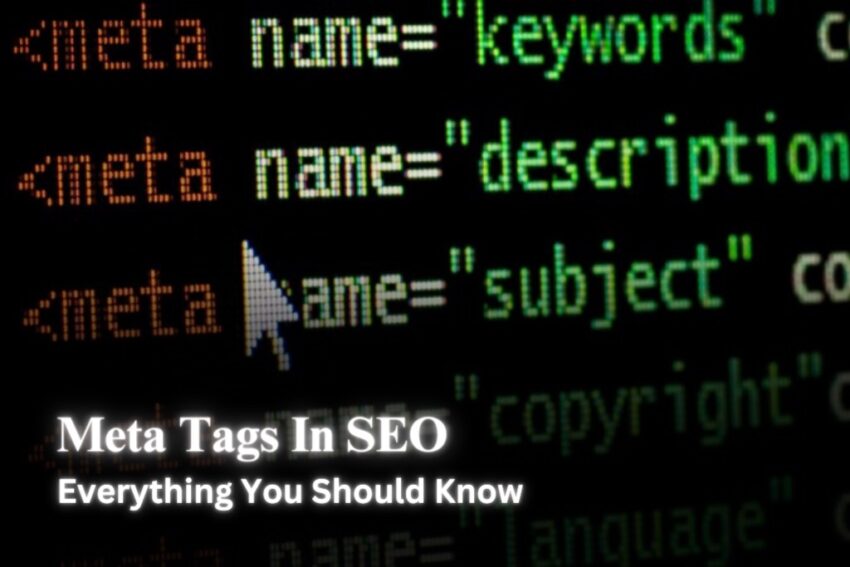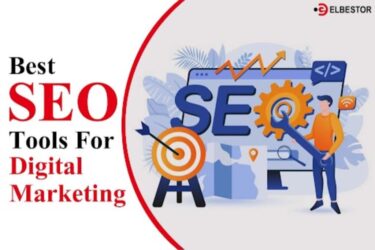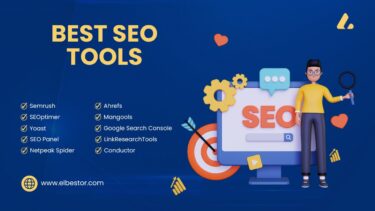These days, the unique elements of search engine optimization (SEO) have become more important for businesses and website owners. Meta tags stand out among the various tools and strategies available to SEO professionals as crucial components in the pursuit of online exposure and success. HTML components known as meta tags give crucial metadata about a web page, helping search engines and affecting how content is shown in search results.
In this blog of Elbestor– The Most Promising Digital Marketing Agency in Bihar and Delhi, we will only talk about Meta Tags in SEO, giving readers a complete overview of its types, purposes, and best practices. We will examine how meta-tag optimization may improve click-through rates, search engine rankings, and user experiences as we go on our trip. Let’s explore the value of Meta Tags in SEO. Let’s get started!
Contents
What Are Meta Tags?
Meta tags are text snippets that describe the content of a page; they exist only in a page’s source code, not on the actual page. Meta tags are just short content descriptions that help search engines understand the subject matter of a web page.
The main distinction between tags you can see (on a blog post, for example) and tags you can’t see is their placement: meta tags are only present in HTML and are often found at the “head” of the page, making them only accessible to search engines (and Internet users who know where to look). The “meta” in these tags stands for “metadata,” which is data about the information on your page.
Why Do Meta Tags Matter?
As was already discussed, meta tags provide search engines and website users that find your site in the SERP additional information about it. They may be enhanced to draw attention to the most crucial parts of your content and elevate your website in search results.
A pleasant user experience is something that search engines appreciate more and more, and part of that is making sure that your site responds to a user’s query as effectively as it can. The information that searchers need to know about your website is provided upfront in a clear and helpful manner thanks to meta tags, which aid in this.
The page structure of your website will be improved by some meta tag types, while other meta tag types instruct search engines which elements of your page to prioritize and which to ignore. There are many different kinds of meta tags that serve various purposes; not all of them are important for SEO. Let’s talk about the important types of Meta Tags.
Different Types Of Meta Tags
Meta tags are HTML components that contain information about a web page. They provide a channel for webmasters to share important information with search engines and website visitors. There are many different types of meta tags, but the following are the most crucial:
Title Tag
The title tag serves as your primary and most crucial anchor. The <title> element is often shown as a clickable headline in SERPs, as well as on social networks and in browsers. But, as they have for many years, do they have a significant influence on rankings?
User behavior elements have received a lot of attention in recent years as logical confirmation of relevance and hence a ranking signal – even Google personnel concede its effect here and there. The title of a website is still the first thing a searcher sees in SERPs to determine whether or not the page is likely to answer the search intent. A well-written one could enhance clicks and traffic, which affect rankings to some extent.
Ideal Techniques
- Give each page a special title that clearly and properly summarizes its information.
- Keep the titles between 50 and 60 characters long to avoid shortening the SERPs. Keep in mind that lengthier titles on the SERP are condensed to between 600 and 700 pixels.
- Prioritize important keywords, but do it organically, as if you were writing titles for readers only.
- Use your brand name in the title; even if it doesn’t appear on the SERPs, it will still affect how the search engine interprets the page.
Meta Description Tag
The meta description is a helpful meta tag since it informs search engines and (sometimes) searchers themselves about the subject matter of your page. The meta description element is useful in other ways, even if it does not always display in Google search results. According to Google, keywords in meta descriptions have no effect on your rankings.
However, if your site’s meta description includes the search terms, you may be able to persuade them to click through from the SERP to your page. A high click-through rate from the SERP may also assist your rankings. Google’s intentions are obscure, but their actions are unequivocal: meta descriptions are now far more significant than meta keywords.
Ideal Techniques
- Give each page a special meta description that expresses the importance of the page.
- The maximum character count for Google’s snippets is normally 150–160 characters (including spaces).
- Include your most important keywords so they will stand out on the actual SERP. However, avoid keyword stuffing by not making your description only of your target keywords.
Header Tag
Header tags are a component of your text. These tags are basically used to organize your website and web content. Header tags may enhance user experience and readability while also assisting search engines in understanding the subject matter of your article. Your header tags’ hierarchy (from H1 to H6) emphasizes the significance of each part. The page title or article header is normally indicated by an H1 tag, while H2 and below act as subheadings to divide up your material.
Even though header tags are very important, you shouldn’t use them in a huge quantity. Instead, you should focus on quality rather than quantity. Your SEO won’t benefit from having five distinct heading kinds on your page. Instead, strategically employ them to divide up your text and establish each section’s key idea. It is often advised to use just one H1 on a page, while you can use more than one H2 or H3 on a page.
Ideal Techniques
- Keep your heading in match with the text they are describing. Search engines nevertheless take them into account even if they aren’t ranking criteria.
- Always make sure that the headings you use correspond to the tone of the text they are put over. Stay away from titles like “Chapter 1… Chapter 2… Chapter 3…”
- Avoid overusing the tags and the keywords included inside them. It should be easy to read and understand for users.
Canonical Tag
If two pages on your website are nearly identical, you might need to tell search engines which one should be given priority. Alternatively, you could have reprinted content that was syndicated elsewhere on your website. If you employ a canonical tag, you may accomplish both of these things without being penalized for duplicating content.
You are instructing the crawlers as to which URL constitutes the “main” one, which prevents Google from being confused and losing track of your rating on the SERPs. This highlights the proper URL and stops the SEO of the others from being harmed.
Ideal Techniques
- Pages containing related information on the same topic.
- The same pages are accessible via several URLs.
- Versions of the same page with different session IDs or URL parameters that have no effect on the content.
- Use the canonical tag with caution for near-duplicate sites: if the two pages connected by a canonical tag differ in content too much, the search engine will simply ignore the tag.
Alt Text
Image optimization has evolved into a critical component of modern SEO since it provides another opportunity to rank in search results, this time with your visual content. Both search engines and individuals should be able to view your photographs. Alt text may accomplish both of these goals: it gives a text alternative to pictures that will be displayed if the image does not load or will be read out by a screen reader, and it tells search engines what that image is supposed to represent.
You can use keywords in your picture alt text if it makes sense; keyword-stuffing this tag will only degrade the user experience for your visitors with accessibility needs.
Ideal Techniques
- Make every effort to optimize the most prominent photos (product photographs, infographics, or training images), which are likely to be searched for in Google Photos.
- Add alt text to sites with little information other than the photographs.
- Keep the alt text clean and descriptive, use your keywords naturally, and make sure they blend in organically with the rest of the page’s content.
Robots Meta Tag
Search engines are told which pages on your website should be crawled using the robots meta tag. Similar to robots.txt, this meta tag prevents a search engine from crawling certain pages, as opposed to an entire site or a particular area of a site, which is what robots.txt does. robots.txt is a meta element that tells search engine crawlers not to index or follow a page. Crawlers will index and follow your page by default if you don’t add a robots meta tag.
Google also requires links to be nofollowed under certain circumstances. For example, in 2016, it issued a directive to bloggers to nofollow any links that they included as part of a product review, as “these links don’t come about organically”. If you want to nofollow an individual link, you can achieve this by HTML. However, if you wanted to simply nofollow all links on a particular page, you can achieve this with the robots meta tag.
Ideal Techniques
- Close pages that are unneeded, incomplete, contain scant information and have no intention of appearing in the SERPs.
- Delete pages that excessively use up the crawl budget.
- Be careful not to accidentally prevent vital pages from being indexed.
Schema Markup
A specific method of arranging the data on each of your web pages in a way that the search engines can understand is called schema markup. It’s a fantastic feature to implement because it truly benefits everyone. Having organized schema markup greatly improves user experience and has significant SEO benefits.
Search engines can fetch data and grasp the context of words thanks to schema data markup. Because of how much the SERPs have changed, you might not even need to navigate through the results to get the solution to your question. When you apply schema tags to certain page elements, your SERP snippet is filled with useful and enticing information for users.
Ideal Techniques
- Make a map of your most significant pages and choose the ideas that apply to each one.
- Apply the markup carefully, if needed, use Structured Data Markup Helper.
- Make sure the markup isn’t confusing or introduced incorrectly by thoroughly testing it.
Best Practices for Meta Tags in SEO
Now that we know the importance of Meta Tags in SEO, let’s talk about some SEO meta tag best practices:
- Make sure that each page on your website has a distinct and meaningful meta title. Make sure it is true to the text and contains pertinent keywords. To guarantee that it shows properly in search results, keep it to no more than 60 characters.
- Write appealing meta descriptions that shortly explain the contents of the page. Make your link tempting to get visitors to click on it. To prevent shortening, keep the description within 160 characters.
- Find appropriate keywords for each page by doing keyword research. Avoid keyword stuffing by naturally incorporating these keywords into your meta title and description.
- To improve readability and professionalism, capitalize the initial letter of each word in your meta title. Titles shouldn’t be written in all capitals.
- Avoid Using Duplicate Meta Tags. The meta title and description of each page should be distinct. Search engines and users may become confused by duplicate meta tags.
Final Words
If you want to make the most of your on-page approach, don’t overlook the minor adjustments that add up to the larger image. Some meta tags are still necessary since they contribute to the taxonomy of your page. Even while certain tags may not be necessary, they can put you one rich snippet ahead of rivals who didn’t bother. Both parties will welcome little adjustments that enhance user experience and aid search engines in understanding your website, and they will undoubtedly pay off in the long run. So, just use the Meta Tags properly or you can contact Elbestor. We will do this for you!







